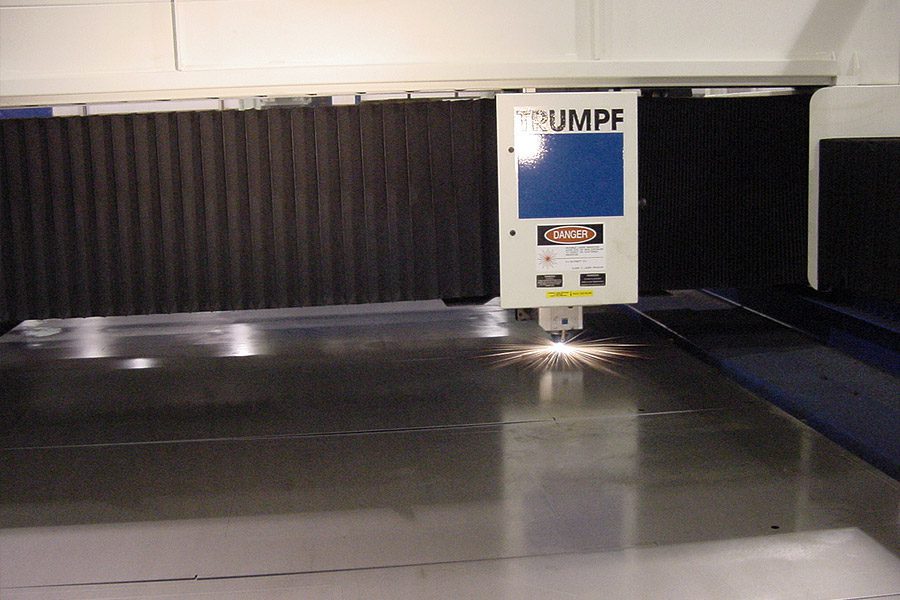Plasma vs. Laser vs. Water Cutting
Plasma, laser or water cutting? Nearly everyone involved with metal fabrication has come across this question. However, there’s no definitive answer. It all depends on what you value most. To solve this dilemma, here is a breakdown of the economic and technical aspects of the main metal cutting solutions.

High definition plasma cutting
Plasma jet cutting utilizes an electrically-conductive gas to transfer energy from an electrical power source through a plasma cutting torch and into the material that is being cut. Renowned for its ability to cut a variety of metals, high definition plasma cutting is the most cost effective of the three options detailed here:
Advantages
- Cuts a wide variety of metals
- Delivers accuracies better than 0.008”
- Impressive hole quality
- Economical
- Rapid cutting speeds
Disadvantages of plasma cutting
- Less accurate than water and laser
- Dealing with different materials requires that you change cutting edge.
- Produces fumes in the cutting process
- Poor edge quality on some materials
Laser cutting
Laser metal cutting uses laser beams to cut materials. It is more precise than plasma cutting and uses less energy when cutting aluminum and steel. Here are some of the advantages of laser cutting:
Advantages of laser cutting
- Fast speed
- Allows for cutting of complex shapes at faster speeds without the need for tooling.
- Efficient job processing
- Reliable
- Cuts many materials of varying thicknesses simultaneously
- Can cut very narrow widths
- Cuts both metals and nonmetals
Disadvantages of laser cutting
- Expensive compared to other processes
- High power consumption
- High levels of accuracy are needed when placing lasers
- Hard to use on reflexive metals
Waterjet cutting
Waterjet metal cutting will either use a high pressure jet of water or a combination of water and an abrasive substance, typically granite, to cut a wide variety of materials. Water jets are used to cut soft materials like wood while an abrasive material is added when dealing with tough metals. Here are some of the advantages of using waterjet in industrial cutting:
Advantages of Waterjet cutting
- Can cut into virtually any kind of material
- Does not overheat the material adjacent to the cut thus maintaining its form.
- Produces no hazardous waste
- Reduces disposal costs
- Highly accurate
- Can cut thick materials
Disadvantages of Waterjet cutting
- Process generates abrasive dust that can hinder movement in machine parts.
- Slow cutting speeds for most metals
- Noisy, unless when cutting is done underwater
- Abrasive materials tend to be expensive
Plasma vs. Laser vs. Water Cutting Comparison Guide
Having looked at the definitions, advantages, and disadvantages of each cutting method, it is now time to examine how they compare against each other.
Cost
Regarding purchasing cost, a plasma cutting is the most cost effective while the laserjet is the most expensive. For operating cost, when you take into consideration the materials used for each machine, plasma will again score the lowest price with waterjet being the most expensive.
Speed of Operation
The production rate of these metal cutting machines is determined by their cutting speeds. Waterjet is the slowest (especially on thick materials) followed by laserjet. Plasma jet is the fastest.
Cutting edge quality
The precision of a cutting machine is normally determined by comparing the actual measurements of the resulting part compared to the programmed part size. Due to less heat distortion, waterjet cutting is the most accurate, followed by laser and finally plasma. However, it is worth noting that on thick materials laserjet can cause distortion.
Precision plasma, laser and water cutting is the key to accurate and high-quality manufacturing. Swanton Welding offers reliable metal cutting services that will help you meet all your deadlines and budgetary goals whilst upholding production quality standards. No matter which type of metal cutting is right for your project Swanton Welding can carry it out for you today.

